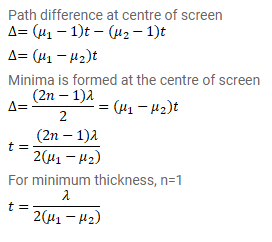Question:
Two transparent slabs having equal thickness but different refractive indices $\mu_{1}$ and $\mu_{2}$ are pasted side by side to form a composite slab. This slab is placed just after the double slit in a Young's experiment so that the light from one slit goes through one material and other slit goes through the other material. What should be the minimum thickness of the slab so that there is a minimum at the point $p_{0}$ which is equidistant from the slits?
Solution:

